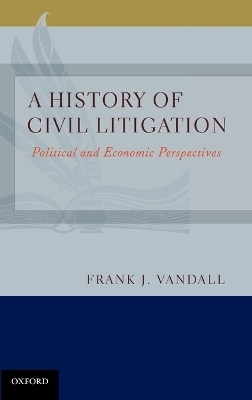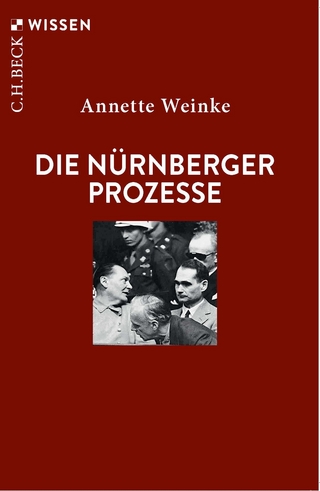
A History of Civil Litigation
Oxford University Press Inc (Verlag)
978-0-19-539191-6 (ISBN)
A History of Civil Litigation: Political and Economic Perspectives, by Frank J. Vandall, studies the expansion of civil liability from 1466 to 1980, and the cessation of that growth in 1980. It evaluates the creation of tort causes of action during the period of 1400-1980. Re-evaluation and limitation of those developments from 1980, to the present, are specifically considered.
The unique focus of the book is first, to argue that civil justice no longer rests on historic foundations, such as, precedent, fairness and impartiality, but has shifted to power and influence. Reform in the law (legislative, judicial, and regulatory) is today driven by financial interests, not precedent, not a neutral desire for fairness, and not to "make it better." It uses products, cases and policies for much of its argument. These policies can be summarized as a shift from a balanced playing field, negligence, to one that favors injured consumers. The strict liability foreshadowed by Judge Traynor, in Escola v. Coca Cola (1944), was not adopted until 1962, when Traynor wrote the majority opinion in Greenman v. Yuba Power Products for the California Supreme Court. Second, the book examines the role of persuasive non-governmental agencies, such as the American Law Institute, in reforming and shaping civil justice.
Never has it been less true that we live under the rule of law. Congress, agencies and the courts make the law, but they are driven by those who have a large financial stake in the outcome. Today, those with power shape the character of products liability law, at every turn.
Frank J. Vandall is one of the most senior faculty members at Emory University School of Law, where he has taught for over 40 years. He teaches Torts and Products Liability and has a casebook in each subject. He was a visiting scholar at the London School of Economics and the Roger Traynor Research Scholar at Hastings College of the Law. He taught in Ohio and Georgia and has presented papers in England, Germany, Greece and Switzerland. His areas of emphasis are public policy, tobacco and gun litigation. He has written seven books dealing with diverse subjects, such as strict liability and police training, and he has authored over thirty-five civil litigation articles on topics such as the Ford Pinto, the social costs of tobacco, casino gambling, city suits against gun manufacturers and internet gambling.
INTRODUCTION
CHAPTER I
The Development of Civil Liability 1466-1916
I. The Period 1400-1850
II. The Period 1850 - 1916
CHAPTER II
The Dissatisfaction With Negligence: Policies Supporting Strict Liability 1916-1980
A. Abnormally Dangerous Activities
B. Res Ipsa Loquitur
C. The Laws Dissatisfaction In Regard to the Theory for Resolving Products Cases
1. Dissatisfaction with Commercial Law
2. Negligence Leads to Unjust Results
3. Specific Policy Reasons for Strict Liability
a. Loss Shifting
b. Safety
c. Superior Knowledge
d. Insurance
e. Economic Analysis of Strict Liability
f. Distance from the Manufacturer
g. Strict Liability Avoids Universal Healthcare
CHAPTER III
The Core Issue In Strict Liability: An Appropriate Test For Defect
I. The Emergence of Strict Liability
II. The Several Tests for Defect
A. Section 402A: "Defective Condition Unreasonably Dangerous"
B. The Risk-Benefit Test
C. The Barker v. Lull tests
D. Negligence with Imputed Knowledge
E. The Communicative Tort
F. The Cheapest Cost Avoider
G. Absolute Liability
III. Comparative Fault
IV. The Role of the Court and the Jury Under Strict Liability
A. The Court
B. The Jury
C. Cases Applying the Restatement 2d, § 402A
V. An Embrace of Negligence
Conclusion
CHAPTER IV
Legal Reform Emanates From The Corporate Boardroom, 1980-Present
I. Constrictions in Legal Theory
II. Procedural Retrenchments: The Presentation Of The Products Case In The Courtroom
III. Other Legislation Designed to Impede the Victim's Access to the Courts
A. State Legislative "Reforms" of Products Liability Law
1. The Impetus for Legislative Change
2. A Radical Change: The Statute of Repose
3. Further Alterations to the Products Liability System
a. Compliance with Governmental Standards
b. The State of the Art Defense
c. Misuse
d. Other Alterations that Further Protect the Powerful
B. Comparison of Fundamental Tort Policies with the State Legislative Reforms
1. Loss Shifting
2. Prevention
3. Judge Learned Hand's Theory
4. Precedent
5. Justice and Administration
IV. Powerful Institutes and Associations Rewrite the Law.
A. The American Law Institute (ALI)
1. The Tripartite Structure of Section 2: Magic Boxes
a. The Structure of Section 2
b. Section 2: The Practice
c. The Draft Lacks an Analysis of the Traditional Policies Underlying Strict Liability
d. Section 6(c) Design Defects in Drugs: A Tabula Rasa
e. The Restatement (Third) of Torts: Products Liability Section 2(b) Does not Reflect the Law
2. The Restatement (Third) Section 2(b) Design Defect, Should Be Rejected
a. Under the Restatement (Third) Fewer Suits Will Be Brought.
b. Institutionalizing Needless Ambiguity
3. An Examination of the Cases that have Considered Reasonable Alternative Design Since Promulgation Of The Restatement (Third) Section 2(b)
a. States That Have Rejected the Restatement (Third)'s Reasonable Alternative Design Requirement
i. California
ii. Missouri
iii. Maryland
iv. Pennsylvania
b. States That Hold Reasonable Alternative Design Is One of Several Factors to Consider in Determining Whether a Product Design is Defective
i. Colorado
ii. New York
iii. Oregon
c. States That Mention the Reasonable Alternative Design Requirement Favorably
i. Georgia
ii. New Jersey
iii. Michigan
d. States That Have Incorporated the Restatement's Reasonable Alternative Design Requirement Into Their Statutes
i. Louisiana
ii. Texas
iii. Mississippi
4. You Won, Now Let's Reduce the Amount of Your Recovery: Apportionment
a. History of Joint and Several Liability
b. Analysis of the ALI's Proposal to Eliminate Joint and Several Liability
c. Analysis of the Potential Impact of the Restatement (Third) Apportionment on the Pennsylvania Law of Joint and Several Liability.
i. Track A
ii. Track B: Several Liability
B. The Council for Tobacco Research
C. The American Association for Justice
Appendix A
CHAPTER V
Corporations Write The Law
I. Tobacco Litigation
A. The 1960s and the Green v. American Tobacco Co. Case
B. The Cipollone v. Liggett Group, Inc. Case
C. The Castano v. American Tobacco Co. Case
D. Why the Early Cigarette Trials Were Lost
E. The Theory and the Visionaries That Won the War
F. The Tobacco Settlement
1. Components of the Settlement
2. Post-Settlement
G. A Solution to the Power That Tobacco Exercises Over the Legal System
1. The History, Policy, and Economics of Absolute Liability as Applied to Cigarette Manufacturers
a. A Historical View of Absolute Liability
b. The Reasons for Applying Absolute Liability to Tobacco Manufacturers
i. Reallocating the Loss
ii. Health Protection
iii. Superior Knowledge
iv. The Cheapest Cost Avoider
v. Economic Analysis
vi. Other Considerations
c. Absolute Liability for Damages from Smoking
d. The Policies Supporting A Modification To Cause In Fact
e. The Cause in Fact Proposal
II. Gun Policy
A. Suits Against The Gun Manufacturers Have Foundered In The State Courts
B. The United States is Facing a Gun Violence Epidemic
C. An Analysis of Gun Control and Liability
1. Self Protection
2. Enforce Existing Gun Laws
3. Personal Responsibility
4. Economic Impact
D. Immunity Legislation for Firearms Sellers.
III. The SUV Rollover Index
CHAPTER VI
THE APPLICATION OF CONCEPTS TO CONTEMPRARY EXAMPLES
A. Lobbies Are Effective
B. Government Rewards the Powerful: Corporate Bailouts
C. Examples of Weak Regulations and Agency Policy Favoring the Regulated Industry: Pharmaceuticals, Aircraft and Securities.
1. Pharmaceutical Regulation
2. Aircraft Regulation
3. The SEC ? Madoff Example
D. Persuasive Organizations
E. Corporations Dictate Morality
F. Proximate Cause v. Tort "Reform"
G. The Supreme Court
H. Congress, Agency Failure, Lobbying and Crashes: The Toyota Example
Conclusion
Index
| Erscheint lt. Verlag | 10.2.2011 |
|---|---|
| Verlagsort | New York |
| Sprache | englisch |
| Maße | 236 x 163 mm |
| Gewicht | 517 g |
| Themenwelt | Geschichte ► Teilgebiete der Geschichte ► Militärgeschichte |
| Recht / Steuern ► EU / Internationales Recht | |
| Recht / Steuern ► Privatrecht / Bürgerliches Recht ► Zivilverfahrensrecht | |
| Recht / Steuern ► Rechtsgeschichte | |
| ISBN-10 | 0-19-539191-8 / 0195391918 |
| ISBN-13 | 978-0-19-539191-6 / 9780195391916 |
| Zustand | Neuware |
| Haben Sie eine Frage zum Produkt? |
aus dem Bereich


